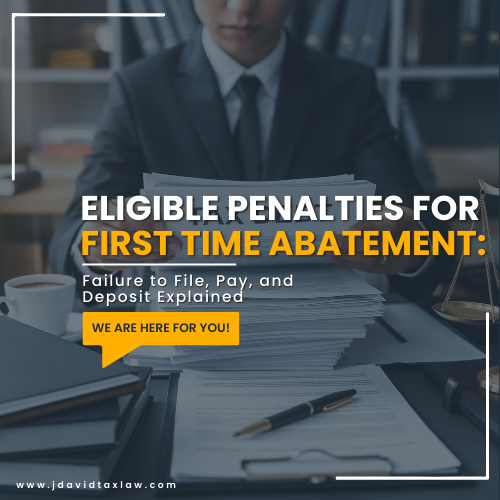Facing the IRS with a hefty tax bill can seem like a financial nightmare, but there’s a remedy that could significantly lighten the load—the Offer in Compromise (OIC) program. This unique opportunity allows taxpayers who meet strict criteria to negotiate their tax debts and potentially reduce the amount they owe.
In this blog, we will discuss the OIC program, how it works, who it benefits, and the steps involved in making a compelling case to the IRS. From the application process to understanding the critical nuances that can make or break your application. Having a tax attorney can guide you through the process and get the relief that you need in no time!
What is an Offer in Compromise?
An Offer in Compromise (OIC) is a program from the Internal Revenue Service (IRS) that allows qualified individuals with unpaid tax debts to negotiate a settled amount. This is less than the total owed to clear their debt.
The aim is to agree on a reduced amount that is manageable for the taxpayer while still accommodating the collecting capabilities of the IRS. Overall, the OIC program provides a viable solution when payment in full would create financial hardship.
Here are the three different types of Offer in Compromise:
The IRS considers various factors when determining eligibility for an OIC, including the taxpayer’s ability to pay, income, expenses, and asset equity. It looks for cases where it seems unlikely that the tax liability can be collected in full and where an OIC would reflect a fair and equitable outcome.
Eligibility Requirements
To be eligible for an OIC, taxpayers must have filed the following:
all tax returns,
made all required estimated tax payments for the current year, and
federal tax deposits for the current quarter (for business owners).
Note: taxpayers are not eligible if they are in an open bankruptcy proceeding.
One common misconception is that an OIC is easily accessible and can be used to quickly resolve tax debts at a significant discount. In reality, the process is rigorous and suited for those who genuinely cannot pay the tax debt in full. It is not for anyone who is just looking for a discount. This tax relief program has its own set of requirements and processes that you need to comply with.
Application Process for an Offer in Compromise
Applying for an Offer in Compromise (OIC) involves a detailed and structured process, where accuracy and thorough documentation are paramount. Here’s a step-by-step guide to help you navigate the application:
Check Eligibility: Before you begin, ensure that you meet all the basic requirements for an OIC, including filing all required tax returns and making necessary estimated tax payments.
Gather Financial Documentation: Collect all relevant financial information that will demonstrate your financial situation, including:
assets,
income,
expenses, and
liabilities.
Complete the Necessary Forms:
Form 656, Offer in Compromise: This form is where you propose the offer amount you’re willing to pay to the IRS. It includes your personal information, tax periods involved, and the reason you believe your offer should be accepted.
Form 433-A (OIC), Collection Information Statement for Wage Earners and Self-Employed Individuals or Form 433-B (OIC), Collection Information Statement for Businesses: These forms require detailed information about your financial situation. For individuals, it covers aspects like employment, bank accounts, assets, credit, and monthly income and expenses. Businesses need to provide similar information at a corporate level.
Pay Application Fee and Initial Payment: As per current guidelines, a non-refundable application fee and a first payment must accompany your OIC application, unless you qualify for a low-income certification or are submitting a Doubt as to Liability offer.
Submit the Application: Send your completed forms, along with the initial payment and any required documentation, to the IRS. The address to which you send your packet varies based on the state you reside in and can be found in the instructions for Form 656.
Wait for Response: After submission, you will wait for the IRS to review your application. This can take some time as the IRS assesses the details of your case.
Compliance with Terms: If your offer is accepted, you must meet all the terms of the agreement. It includes staying up to date with all the payment requirements for the next five years. You must also comply with your payment plans to settle your unpaid taxes.
Accurate financial disclosures are crucial when applying for an OIC. The IRS closely scrutinizes the information provided to assess your true ability to pay. Inaccuracies, whether intentional or not, can lead to the rejection of your offer. In some cases, it could result in legal consequences for fraud and other tax debt issues.
Conclusion
An offer in compromise is an effective solution for those struggling with overwhelming tax debt. By understanding the detailed requirements and carefully preparing your application with your tax lawyer, you have the opportunity to significantly reduce your financial burden.
If you’re feeling overwhelmed by the process or unsure if you qualify for an OIC, professional guidance is just a call away. Contact J. David Tax Law today at (888) 342-9436 for expert assistance. The firm’s experienced tax attorneys can help you evaluate your situation and effectively advocate on your behalf.
Remember, the key to a successful OIC application lies in transparency and meticulous documentation of your financial status.




















